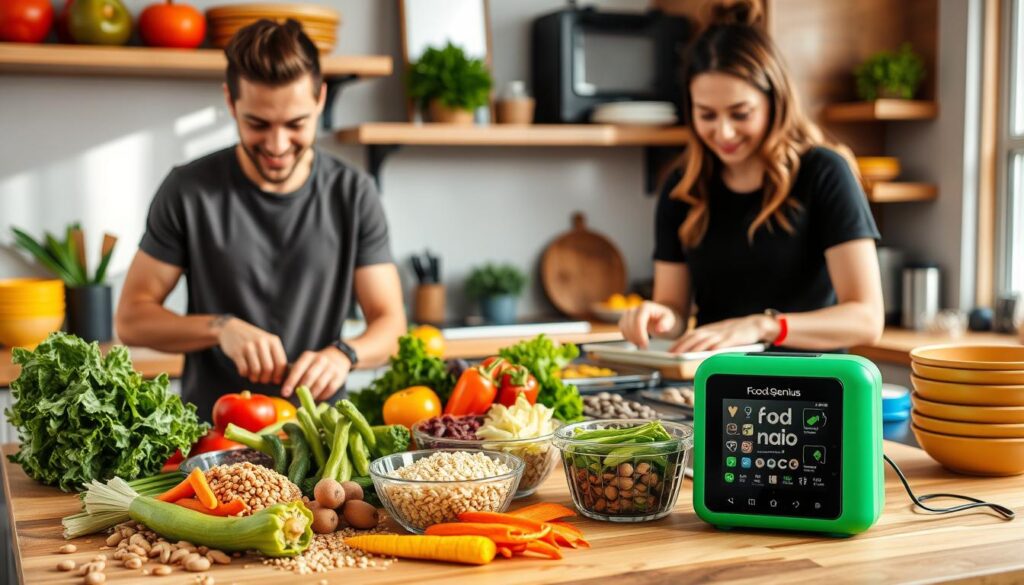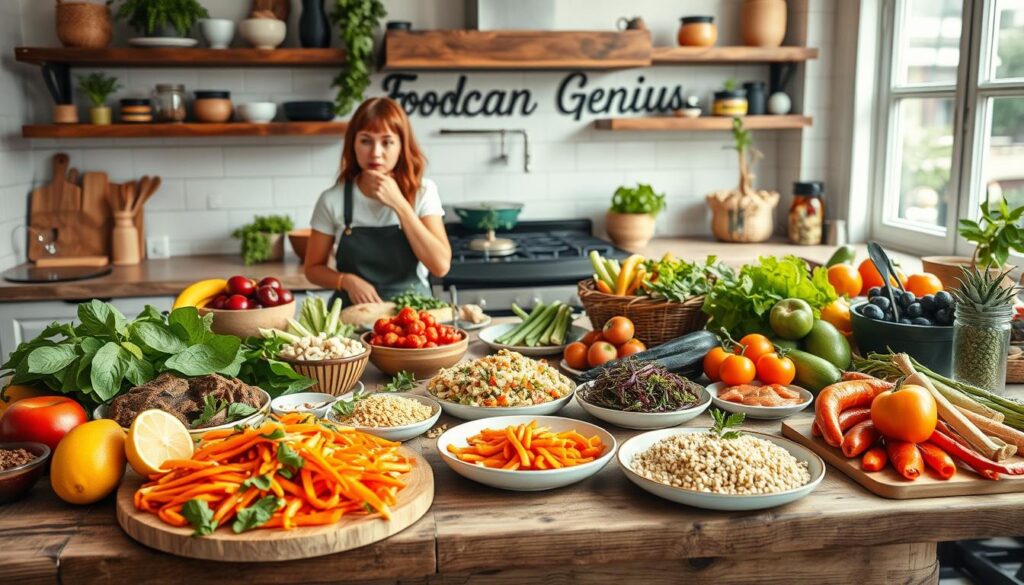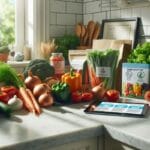Imagine a world where your plate is full of vibrant, healthy plants. You’ll feel good knowing you’re helping the planet. The vegan lifestyle changes your health and values for the better.
Starting a vegan diet can seem hard, but it’s worth it. You might choose it for animal welfare, the environment, or your health. With the right tools, like the Food Scan Genius app, going vegan is easier than you think1.
Did you know 20 percent of people want to eat more vegan foods1? This shows many are interested in a plant-based diet. The Food Scan Genius app makes this journey simpler and healthier.
Key Takeaways
- Going vegan is a gradual journey – take it one step at a time.
- Explore plant-based alternatives to your favorite foods for an easy transition.
- Remember your motivations, whether for animal welfare, health, or the environment.
- The Food Scan Genius app can help you navigate the vegan lifestyle with ease.
- A vegan diet offers numerous health benefits, from reduced disease risk to improved cognitive function.
Understanding the Vegan Lifestyle
Veganism is more than just what you eat. It’s a way of life that rejects animal cruelty and exploitation2. Vegans eat only plant-based foods, avoiding animal products like dairy and eggs2. They should aim for 5 servings of fruits and veggies every day2.
What Does It Mean to Be Vegan?
Vegans don’t eat anything from animals2. The Eatwell Guide helps everyone, including vegans, eat well2. They get important nutrients from plants, like calcium and vitamin B12, from fortified drinks and greens2.
The Benefits of Veganism
Being vegan is good for your health3. It can lower your risk of type 2 diabetes by up to 78%3. Vegans also face a 75% lower risk of high blood pressure and a 42% lower risk of heart disease3.
They might also have a 15% lower risk of cancer3. Vegan diets can ease arthritis symptoms and might protect against Alzheimer’s3.
Common Misconceptions About Veganism
Many people still misunderstand veganism4. Only a small percentage of Americans are vegan4. Some vegans choose it for health, while others avoid cooked foods4.
There are different types of vegans, like those who eat oysters4. With the right planning, veganism can be a fulfilling choice4.
“Veganism is not a diet, it’s a lifestyle. It’s about making conscious choices to reduce animal suffering and environmental impact.” – Unknown
Getting Started with Plant-Based Eating
Starting a vegan lifestyle is easier than you think. Just take it one step at a time. Begin by looking at your diet and finding ways to add more plant-based foods.
Assessing Your Current Diet
Look closely at what you usually eat. Make a list of your meals and snacks. This will show you where you can easily switch to vegan options5.
Simple Swaps to Make Transition Easier
Start with small changes. Try using plant-based milk instead of dairy6. Also, replace meat with tofu, tempeh, or plant-based burgers5. These changes can help you slowly move towards a vegan diet.
Planning Your First Vegan Meals
Make a list of vegan dishes you already like or can easily make vegan. Think about veggie stir-fries, bean and rice bowls, or pasta with marinara sauce6. Use these as a starting point and add new recipes as you get more confident in cooking7.
Visit health food stores and use apps like Happy Cow to find vegan restaurants. With some planning and creativity, you can enjoy tasty, healthy vegan meals.
| Nutrient | Recommended Daily Amount | Vegan-Friendly Sources |
|---|---|---|
| Protein | 50 grams per day for adults5 | Quinoa, lentils, chickpeas, tofu, tempeh5 |
| Calcium | 1,000-1,200 mg per day | Fortified plant-based milk, leafy greens, tofu |
| Vitamin B12 | 2.4 mcg per day | Nutritional yeast, fortified cereals, supplements |
“Making small changes to everyday meals is one of the easiest ways to increase plant-based foods in the diet.”6
Essential Vegan Staples to Include
Starting a vegan lifestyle is easy. Just fill your pantry with the right vegan essentials. You’ll be making tasty, healthy meals in no time8.
Must-Have Vegan Ingredients
For vegan cooking, a well-stocked pantry is crucial. Keep beans, lentils, and chickpeas on hand9. Also, have whole grains like brown rice, quinoa, and steel-cut oats ready9.
Nuts, seeds, and nut butters are also key. They add protein, healthy fats, and nutrients9.
Flavor boosters are important too. Garlic powder, onion powder, cumin, and paprika can elevate your dishes8. Nutritional yeast, plant-based milk, and tahini add creaminess and depth9.
How to Stock Your Pantry
Build your vegan pantry with whole, minimally processed foods10. Start with grains, legumes, nuts, and seeds. Then add condiments, spices, and plant-based milks8.
Include canned tomatoes, vegetable broth, and nut butters for easy meal prep9.
Tips for Fresh Produce Shopping
Adding fresh produce to your pantry is vital. Choose a variety of fruits and vegetables for nutrients10.
Variety is key in a vegan diet. Try new ingredients, cuisines, and cooking methods. This keeps your meals interesting and satisfying8. With the right vegan staples, you can create endless delicious dishes!
Meal Prep for Vegan Success
As vegan enthusiasts, we know meal planning and prep are key. A little time upfront sets us up for a week of nourishing, plant-based meals. Meal prepping saves time and ensures a balanced diet with vibrant, vegan-friendly ingredients.
Benefits of Meal Prepping
Meal prepping has many benefits for vegans. It takes about 3-4 hours, including prep, cooking, and storage11. Making 2 recipes that yield 4 servings each can last five days11.
This approach boosts culinary variety, reduces decision fatigue, and helps shop smart to avoid waste.
Easy Vegan Meal Prep Ideas
To start vegan meal prep, focus on versatile, nutrient-dense staples. Cook large batches of whole grains, legumes, and roasted veggies. These can be mixed and matched all week.
Make flavorful sauces, dressings, and dips to enhance your meals. Use a variety of plant-based colors to get a range of vitamins and minerals11.
How to Store Meal Prep Effectively
Proper storage keeps your vegan meal prep fresh. Use high-quality, airtight containers. Label each with contents and date to streamline your week.
Consider the Food Scan Genius app11 for vegan-friendly storage tips and shelf life.
Embracing vegan meal prep lets us enjoy nourishing meals while saving time. With a bit of planning, we’re on our way to vegan success!

Finding Vegan Recipes You’ll Love
Starting a vegan lifestyle doesn’t mean you have to give up on taste or creativity. The vegan world is full of tasty and varied recipes. You can find everything from classic dishes to dishes from around the world.
Resources for Vegan Recipes
Vegans avoid animal exploitation as much as they can12. Online vegan food bloggers and YouTubers are great resources. They share amazing recipes, from easy weeknight meals to fancy dishes12. Tofu is a favorite ingredient, showing its popularity in vegan cooking13.
Recommended Cookbooks and Blogs
Vegan cookbooks are also a great help. Try “The Kind Diet” by Alicia Silverstone or “Food Matters” by Mark Bittman. They have lots of vegan recipes and tips. Blogs like Minimalist Baker, Oh She Glows, and Forks Over Knives are full of tasty, healthy vegan meals.
How to Customize Recipes to Your Taste
Feel free to make vegan recipes your own12. You can change ingredients or spices to suit your taste12. Many vegans also like to cook in batches for a healthy lifestyle13.
Vegan cooking is all about being flexible12. There are countless vegan bloggers with their own twist on dishes12. It’s a chance to try new things and find your favorite vegan dishes.
So, whether you’re an experienced vegan chef or just starting, there’s a world of vegan recipes waiting for you. Get ready for a tasty and fulfilling cooking journey1213!
Navigating Social Situations as a Vegan
Being a vegan can feel like walking through a minefield. The benefits of eating plants are clear14, but vegans are just 3% of the population14. This small number makes us often the minority, facing challenges at meals, family events, and with friends.
Tips for Eating Out
Going to vegan-friendly restaurants is usually the best choice. Apps like Happy Cow help find great vegan places14. Always check menus ahead or call to ask about vegan options. This way, you’ll enjoy your meal and avoid any awkward moments.
Handling Family Gatherings
Family gatherings can be tricky, but planning helps a lot. Bringing a tasty vegan dish to share is a good idea15. It ensures you have something good to eat and introduces your family to vegan food15. Being inclusive can help your family understand and appreciate your vegan choice.
Discussing Your Choice with Friends
16 Social challenges are a big hurdle for vegans, with 67% worried about social situations16. When talking to friends, share your personal reasons, not try to change them. Be empathetic and ready to clear up any wrong ideas they might have15. Showing love and kindness can lead to better understanding and even change in their views on veganism.
Dealing with social situations as a vegan is about balance. Stand up for your beliefs while keeping relationships strong. With the right attitude and some planning, you can use these challenges to share the good of veganism and connect more deeply with others.
“Compassion is the signature of higher consciousness. It is through compassion that a person achieves the highest peak and the deepest reach in their evolution.” – Amit Ray
Understanding Nutritional Needs on a Vegan Diet
Starting a vegan diet means knowing what nutrients your body needs. You can get these from plants, but you need to pay attention to avoid missing out on important nutrients17.
Key Nutrients to Focus On
- Protein: Make sure you get enough from nuts, seeds, tofu, tempeh, legumes, and vegan protein powders17.
- Iron: Eat foods high in iron like lentils, spinach, cashews, and fortified cereals18.
- Vitamin B12: Since plants don’t have B12, take a supplement or eat fortified foods17.
- Omega-3s: Use flaxseeds, walnuts, and algae-based supplements for omega-3s17.
- Calcium: Leafy greens, fortified plant-based milks, and tofu are good calcium sources18.
How to Avoid Deficiencies
Eat a variety of whole, plant-based foods to avoid deficiencies1718. If you’re new to veganism, talk to a registered dietitian to make sure you’re getting everything you need18.
Supplements to Consider
Even with a good vegan diet, some supplements might help, especially at first. These could be B12, iron, omega-3s, and vitamin D1718. Always check with a doctor before starting any supplements18.
A balanced vegan diet is naturally anti-inflammatory, reducing inflammation linked to diseases like type 2 diabetes and heart disease.”17
Changing to a vegan diet is a journey. It might take time to find what works best for you. With some planning and the right help, you can do well on a plant-based diet19.
Maintaining Variety in Your Vegan Diet
Starting a vegan lifestyle doesn’t mean you have to miss out on taste or fun. It’s a chance to explore the wide world of plant-based foods. You can try everything from Indian spices to Middle Eastern dishes, making your meals exciting.
Exploring Global Cuisines
Being vegan means you get to try new foods and cooking methods from all over. Try Indian curries, Ethiopian stews, or Mediterranean herbs and dips.  This way, you’ll keep your meals interesting and your body full of nutrients.
This way, you’ll keep your meals interesting and your body full of nutrients.
Seasonal Ingredients to Try
Using seasonal produce is good for the planet and tastes better. In spring, try asparagus, peas, and greens. Summer has tomatoes, corn, and berries. Autumn and winter offer roots, squashes, and brassicas.20 Switching your meals with the seasons keeps your diet fresh and your body healthy.
Creative Cooking Techniques
Get creative with your vegan cooking. Try fermenting, sprouting, or air frying for new flavors and textures. The Food Scan Genius app can also help you find new vegan products. With a bit of creativity, you’ll make amazing vegan dishes.
| Nutrient | Recommended Daily Intake | Vegan-Friendly Sources |
|---|---|---|
| Protein | 46 grams for women, 56 grams for men20 | Dry oatmeal, peanut butter, chickpeas, quinoa, almonds, whole-wheat spaghetti, tofu20 |
| Vitamin D | 600 IU (some experts suggest 1,500 IU)20 | Fortified plant-based milks, cereals, and supplements20 |
| Vitamin B12 | 2.4 micrograms20 | Fortified cereals, energy bars, or supplements20 |
By exploring different cuisines, using seasonal foods, and trying new cooking methods, you can keep your vegan diet exciting and healthy. The Food Scan Genius app is there to help you find new vegan products and keep your meals interesting.
Staying Inspired on Your Vegan Journey
Starting your vegan journey? It’s key to keep the spark alive. Join online vegan groups for support and new ideas21. These communities offer recipes, advice, and a sense of belonging21.
Connecting with others who share your vegan values can boost your motivation21. Whether it’s through forums, local groups, or social media, you’ll find inspiration and a healthier food relationship21.
Looking up to vegan chefs and bloggers can be a great way to stay inspired22. They share their stories, tasty recipes, and tips for a vegan lifestyle22. Their enthusiasm can spark your creativity in the kitchen.
It’s important to remember why you chose veganism23. A vegan diet is good for you, animals, and the planet23. Visiting animal sanctuaries or watching documentaries can strengthen your commitment22. Every choice you make towards veganism counts.
FAQ
What does it mean to be vegan?
Veganism is more than just what you eat. It’s about avoiding animal use in all areas of life. It’s a choice to live without animal products for food, goods, or fun.
What are the benefits of a vegan lifestyle?
Being vegan can make you healthier and better for the planet. You might feel more full of energy. Plus, it helps animals and the environment.
What are some common misconceptions about veganism?
Some think vegans don’t get enough protein or have few food choices. But, a well-planned vegan diet meets all nutritional needs. It takes courage and curiosity, but it’s worth learning.
How do I start transitioning to a vegan diet?
Start small by changing your daily meals a little at a time. Begin by using plant-based milk instead of dairy. Make a list of vegan foods you like and try new recipes.
What are some essential vegan pantry staples?
You’ll need non-dairy milk, nutritional yeast, and plant-based proteins like beans, nuts, and seeds. Stock up on fruits, veggies, grains, and healthy fats too.
How can meal prepping help with a vegan lifestyle?
Meal prepping saves time and keeps you eating well all week. Prepare grains, legumes, and veggies ahead. Make versatile sauces and dressings to make meals easy.
Where can I find vegan-friendly recipes and resources?
Look for vegan cookbooks, blogs, and YouTube channels. The Kind Diet” by Alicia Silverstone and “Food Matters” by Mark Bittman are great. You can also swap ingredients or spices to make recipes your own.
How do I navigate social situations as a vegan?
Use the Happy Cow app to find vegan restaurants. Check menus or call ahead when eating out. Bring a vegan dish to family gatherings and talk about your choice with confidence.
What are the key nutrients to focus on in a vegan diet?
Focus on protein, iron, B12, omega-3s, and calcium. Eat a variety of whole foods to get what you need. Consider B12 supplements since it’s not in plants.
How can I maintain variety in my vegan diet?
Try vegan-friendly cuisines like Indian or Ethiopian. Use seasonal ingredients for fresh meals. Experiment with cooking methods like fermenting or air frying to add variety.
Source Links
- How to Go Vegan: A Beginner’s Guide to Eating Plant-Based
- The vegan diet
- The Vegan Diet — A Complete Guide for Beginners
- Ready for Vegan 101?
- How to start a plant-based diet – Mayo Clinic Press
- How to go vegan
- The Beginner’s Guide to a Whole-Food, Plant-Based Diet
- How To Stock a Vegan Pantry (Full Ingredient List!)
- 70+ Essential Vegan Staple Foods For Your Pantry
- Vegan Grocery List: Top 50 Staples for a Meat-Free Diet
- A Beginner’s Guide to Vegan Meal Prep
- Vegan cooking for beginners: get started the easy way (even if you think you’ll never go vegan) – Vegan Family Kitchen
- Recipes Archive – Vegan Family Kitchen – Vegan Family Kitchen
- Navigating Social Situations on Your Vegan Path
- Navigating Social Situations as a Vegan – Animal Advocates of South Central PA
- Navigating Social Situations As A Vegan ft. Colleen Patrick-Goudreau
- Vegan Diet: Foods, Benefits & More
- Understanding a Vegan Diet
- Vegan diet: nutritional components, implementation, and effects on adults’ health
- 9 Healthy Tips to Help You Start Eating a Vegan Diet
- Fuel Your Passion: Staying Inspired on Your Vegan Journey
- How to Help People Go Vegan – JustFit
- Tips for How to Go Vegan and Stay Vegan – Best Served Vegan





